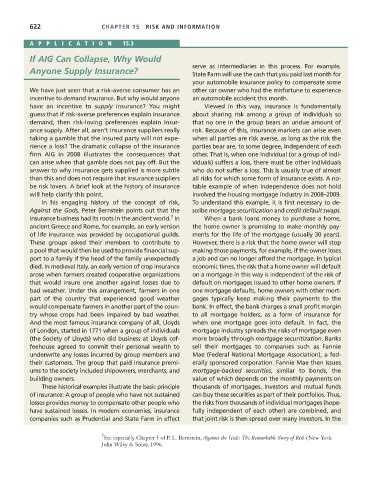Page 648 - Microeconomics, Fourth Edition
P. 648
c15riskandinformation.qxd 8/16/10 11:10 AM Page 622
622 CHAPTER 15 RISK AND INFORMATION
APPLICA TION 15.3
If AIG Can Collapse, Why Would
serve as intermediaries in this process. For example,
Anyone Supply Insurance? State Farm will use the cash that you paid last month for
your automobile insurance policy to compensate some
We have just seen that a risk-averse consumer has an other car owner who had the misfortune to experience
incentive to demand insurance. But why would anyone an automobile accident this month.
have an incentive to supply insurance? You might Viewed in this way, insurance is fundamentally
guess that if risk-averse preferences explain insurance about sharing risk among a group of individuals so
demand, then risk-loving preferences explain insur- that no one in the group bears an undue amount of
ance supply. After all, aren’t insurance suppliers really risk. Because of this, insurance markets can arise even
taking a gamble that the insured party will not expe- when all parties are risk averse, as long as the risk the
rience a loss? The dramatic collapse of the insurance parties bear are, to some degree, independent of each
firm AIG in 2008 illustrates the consequences that other. That is, when one individual (or a group of indi-
can arise when that gamble does not pay off. But the viduals) suffers a loss, there must be other individuals
answer to why insurance gets supplied is more subtle who do not suffer a loss. This is usually true of almost
than this and does not require that insurance suppliers all risks for which some form of insurance exists. A no-
be risk lovers. A brief look at the history of insurance table example of when independence does not hold
will help clarify this point. involved the housing mortgage industry in 2008–2009.
In his engaging history of the concept of risk, To understand this example, it is first necessary to de-
Against the Gods, Peter Bernstein points out that the scribe mortgage securitization and credit default swaps.
7
insurance business had its roots in the ancient world. In When a bank loans money to purchase a home,
ancient Greece and Rome, for example, an early version the home owner is promising to make monthly pay-
of life insurance was provided by occupational guilds. ments for the life of the mortgage (usually 30 years).
These groups asked their members to contribute to However, there is a risk that the home owner will stop
a pool that would then be used to provide financial sup- making those payments, for example, if the owner loses
port to a family if the head of the family unexpectedly a job and can no longer afford the mortgage. In typical
died. In medieval Italy, an early version of crop insurance economic times, the risk that a home owner will default
arose when farmers created cooperative organizations on a mortgage in this way is independent of the risk of
that would insure one another against losses due to default on mortgages issued to other home owners. If
bad weather. Under this arrangement, farmers in one one mortgage defaults, home owners with other mort-
part of the country that experienced good weather gages typically keep making their payments to the
would compensate farmers in another part of the coun- bank. In effect, the bank charges a small profit margin
try whose crops had been impaired by bad weather. to all mortgage holders, as a form of insurance for
And the most famous insurance company of all, Lloyds when one mortgage goes into default. In fact, the
of London, started in 1771 when a group of individuals mortgage industry spreads the risks of mortgage even
(the Society of Lloyds) who did business at Lloyds cof- more broadly through mortgage securitization. Banks
feehouse agreed to commit their personal wealth to sell their mortgages to companies such as Fannie
underwrite any losses incurred by group members and Mae (Federal National Mortgage Association), a fed-
their customers. The group that paid insurance premi- erally sponsored corporation. Fannie Mae then issues
ums to the society included shipowners, merchants, and mortgage-backed securities, similar to bonds, the
building owners. value of which depends on the monthly payments on
These historical examples illustrate the basic principle thousands of mortgages. Investors and mutual funds
of insurance: A group of people who have not sustained can buy these securities as part of their portfolios. Thus,
losses provides money to compensate other people who the risks from thousands of individual mortgages (hope-
have sustained losses. In modern economies, insurance fully independent of each other) are combined, and
companies such as Prudential and State Farm in effect that joint risk is then spread over many investors. In the
7 See especially Chapter 5 of P. L. Bernstein, Against the Gods: The Remarkable Story of Risk (New York:
John Wiley & Sons), 1996.

